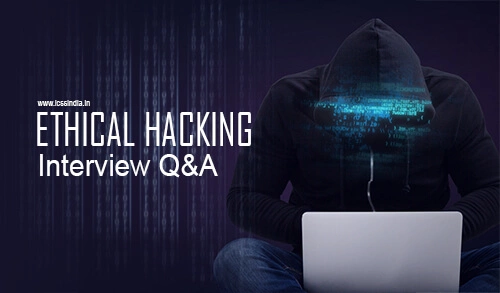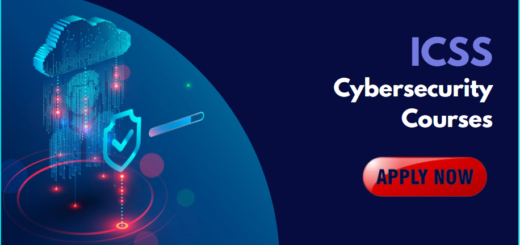Ethical Hacking Interview Questions and Answers 2022

Are you looking for a job in Ethical Hacking? Then you are at the right place as what we at ICSS (International College for Security Studies) have for you is what will change your interview game altogether for the better! Don’t be surprised, read on to know more! Hereafter doing our brainstorming, we have curated the best ethical hacking interview questions just for you! So now it’ll be easier for you to emerge with flying colors in your interview.
These questions are going to help everyone whether someone is a beginner or a professional. But before we move ahead, let me share a very interesting fact with you guys, which is that the field of ethical hacking is fast expanding as a career option because of the increasing cybercrime rate.
Did you also know that there is a huge demand for ethical hackers and the average salary of the working professionals can go up to $80,000 per annum?
Top 20 Ethical Hacking Interview Questions and Answers 2021
Now here let’s get started with the questions –
Q -1 What do you understand by Ethical Hacking?
Ethical hacking is a process of identifying the hacking done by an individual or any organization of some sort. It also helps in understanding the potential threats looming over any computer/system or network. The reason why they are called ethical hackers is that they’re granted permission by the owner to spot the weakness in their network system. This way any sort of probable threats of external hacking can be avoided.
Q-2 Who is a hacker?
A hacker is someone who takes advantage of the shortfalls and weaknesses of someone else’s computer system or network. This activity is usually counted as illegal along with many other activities as stealing personal information, accessing or tampering with the network configuration, sabotaging the user interface of the OS computer.
Q-3 Name the different types of hackers
There are different types of hackers and ways of doing the hacking, mentioned below are a few:
- Black Hat Hackers
- White Hat Hackers
- Blue Hat Hackers
- Grey Hat Hackers
- Skiddie
- Elite Hackers
- Hacktivism
- Newbie
- Organized crime
- Intelligence agencies
Q-4 How would you differentiate between IP address and Mac address?
IP Address: It is assigned to every device so that the device can be identified on the network. In other words, an IP address is just like your postal address, where anyone who knows the postal address of your device can drop you a letter.
MAC (Machine Access Control) Address: A MAC address is nothing, but a unique serial number allotted to every network interface in every device. In other words, it’s like your physical mailbox which only your postal carrier (network router) can detect it and it can be altered with the help of a new mailbox (network card) at any time by imprinting your name (IP address) on it.
Q-5 Can you identify a few tools used by Ethical Hackers?
- Wire Shark
- Meta Sploit
- John The Ripper
- NMAP
- Maltego
Q-6 Define footprinting in ethical hacking? What are the techniques used for the same?
Footprinting is defined as the accumulation and uncovering of the information with respect to the target network before accessing any network. The approach that the hackers adopt before hacking are:
- Open Source Footprinting: It implies looking for the administrators’ contact information which will be used in tracking the password in Social Engineering
- Network Enumeration: It is a process wherein the hacker tries to track the domain name as well as the network blocks of the network targeted.
- Scanning: Once the network is identified, the second step would be to trace the active IP addresses present on the network.
- Stack Fingerprinting: Once the hosts and port have been traced through the process of scanning, the final footprinting step can take place. This is termed Stack Fingerprinting.
Q-7 What are the steps undertaken by the hackers in order to hack a network or a system?
The steps undertaken by the hackers to intrude into the network or system are:
- Reconnaissance: In this, the hacker gathers the information of the user and tracks the weak spots, if any.
- Scanning and Enumeration: Under this, the hacker tries to gather information in order to examine and test the network.
- To gain access: After successfully finishing the first and second phases, the hackers can gain complete access to the network and system.
- Maintaining the access: Since the hacker has gained access to your system in the earlier stage, he will now try to install a few scripts and analyses that if he has complete access to your computer in the future.
- Clearing Tracks: Under this stage, the hacker manages to clear every possible track and tries to make an escape in order to avoid getting detected by the security personnel.
Q-8 Name the different sniffing tools available.
There are various sniffing tools available, but the commonly used are:
- WinDump
- Wireshark
- Diff
- Ettercap
- MSN Sniffer
- EtherApe
Q-9 What is Phishing?
Phishing is a process where the target user is contacted with the help of phone, email, or text message in order to gather such sensitive information as credit card details, passwords, etc.
Learn in detail: What is Phishing Attacks, Identify, Types and Prevention?
Q-10 What is Brute Force Hack?
Brute Force Hack is a technique meant for hacking the password and gaining access to the system as well as network resources. This process takes much time, it requires toa hacker the knowledge of JavaScript. For this, one can use the tool name, i.e. Hydra.
Q-11. What do you understand by the term DOS (Denial of Service) attack? What are the common ways of DOS attack?
Denial of Service involves a malicious attack on the network which is usually done either by flooding the network via driving useless traffic. Even though DOS doesn’t lead to any security breach or theft of information, it can be taxing for the website owner in terms of being levied with a great deal of money and time.
- SYN Attack
- Buffer Overflow Attacks
- Smurf Attack
- Viruses
- Teardrop Attack
Learn in Detail: What is DDoS Attack – All you need to know
Q-12 What is SQL Injection?
SQL is known as one of the techniques wherein the data is stolen from the organizations. It is a fault caused by the application code. SQL injection takes place when you place the content into a string of SQL theory and the outcome mode content into a string of SQL query and the result transforms the syntax of your query in ways you did not mean.
Read Also, Learn Hacking Website with SQL injection
Q-14 Name different types of penetration testing tools.
Penetration testing is used to access the security system of IT and the tools used to perform the same are:
- Metasploit
- Nmap
- Nessus
- Aircrack-ng
- Burp Suite
read also, What is Penetration Testing? How to do Penetration Testing?
Q-15 Why Keylogger is used by hackers?
Keylogger is used by software companies as a basic tool to check and troubleshoot the technical issues present in their systems or in their network. However, hackers use this tool to trace the users’ keystrokes and find access to their confidential matters.
Learn in Detail: What Is Keylogger – Everything You Need To Know
Q-16 How will you define Network Enumeration?
Network Enumeration involves extracting user id, machine names, network resources, and services from a system. This stage is important for a hacker to send queries directly and extract more information about the target who is forming an active connection in the system.
Q-17 Define Pharming and Defacement.
Pharming: It is a technique in which the attacker attacks the user computer or the DNS (Domain Name System) server so that traffic can be directed to the malicious site.
Defacement: Under this technique, the attacker finds a replacement of the organization’s website with a different page. It consists of the hackers’ name, images and perhaps even include messages as well as background music.
Q-18 What are the different types of password-cracking techniques?
These are:
- AttacksHybrid
- AttackBrute Forcing
- AttackRule
- AttackSyllable
Q-19 What is CSRF (Cross-Site Request Forgery) and how it can be prevented?
CSRF involves an attack from a malicious site that sends a request to a web application in which a person is already authenticated from another website. In order to prevent CSRF, you can attach an unknown challenge token to every request and link it with the user’s session. It will help ensure the developer that the received request is from an authentic source.
Learn In detail: What is Cross-site Request Forgery CSRF?
Q-20 What is RAnsweromware?
RAnsweromware is a sort of malware that prohibits the user from using their personal files or system and asks for a ransom in order to gain access to them. Depending upon the seriousness of the attack, ransomware is divided into 3 types, such as:
- Scareware
- Encrypting ransomware
- Screen lockers
Learn in detail: What is Ransomware, How does work, How to Remove and Prevent Ransomware








